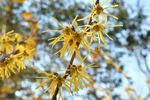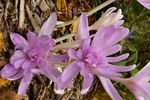Gardening Notes for October
←
→
Page content transcription
If your browser does not render page correctly, please read the page content below
Gardening Notes for October
O ctober marks the true start of autumn and much work for the gardener! We are now
racing against time to complete our chores before that first strong frost. September
was a fairly dry month after tropical storm Ida, so watering chores are certainly high on
the list! Always remember to take a moment and make some notes about your garden.
Among other details, take note of what annuals are still looking respectable, which late
season vegetables are living up to expectations, and perhaps what woody plants or
perennials should be added to enhance the autumn garden for next year!
Things to do:
Bulbs
Finish ordering and start planting spring flowering
bulbs. If you have yet to try fall blooming
Colchicum, give a few a try! It is too late to order
them on line, but many garden centers carry them.
They offer large flowers, upwards of 3” in
diameter in shades of pink, purple and white.
Colchicum x ‘Waterlily’ is an attractive double
form (pictured at right) that usually blooms in
mid-October into early November. I have never
seen seedlings, although the clumps will produce
offsets and increase in size. Plants are also very
long lived, flowering for well over 30 years. The
foliage is often coarse in the spring and goes
dormant come June, so place them where the
foliage will be partially obscured by other
perennials.
Flowers
October is likely to be the last chance to take and root cuttings of tender plants,
such as Spurflower (Plectranthus), Coleus, and Geraniums. Other plants that are
not of hybrid origin can be overwintered by collecting the seed and stored in the
lettuce draw of the refrigerator. Various species of Solanum, Asclepias, Nicotiana
and Amaranthus are ideal for overwintering in this manner. Remember, the
average frost date is October 15th, although frosts appear to be coming later and
we may not receive a killing frost until early November.
Remove the foliage of problematic perennials such as Bearded Iris and Peonies.
The foliage serves as a location for the Iris Borer to lay their eggs and for Peonies,
the old foliage retains the spores for Powdery Mildew. It also helps to reduce
fungal disease for next year and eliminates winter cover for mice, moles and
voles!
Remove annuals that appear tired or are frosted. They can be replaced with an
attractive bed of pansies. During the winter, lightly mulch the pansies with straw
or shredded leaves as they will make a great show come spring. Where possible or in more wild areas, leave the leaf litter behind, since it provides
cover for larvae, pupa of butterflies and moths, egg masses, hibernating native
bees, dormant spiders and many other beneficial insects!
Prepare tuberous rooted
plants for winter. Those
such as Elephant Ears
(Alocasia and Colocasia),
Dahlia, Canna, and Banana
(Musa and Ensete), which
have a storage-type of root
system can be dug, allowed
to dry (as seen at right), cut
back, wrapped in
newspaper, and stored in a
cool (50-55°F), dry
basement. They can also be
potted into a container and kept on the drier side throughout the winter. You need
not wait for a killing frost if you wish to dig them out after a light frost.
For seed producing plants like the various species of Rudbeckia (Black-eyed
Susan) and Echinacea (Purple Cone Flower), it is best to not cut the flower stems
back until spring, since the seeds provide food for Gold Finches and other seed
loving birds. Butterflies also seek shelter under flower heads during early fall.
The Large Coneflower (Rudbeckia maxima) is a favorite seed source for many
birds and is pictured at the end of the article.
Ornamental Grasses are typically left standing for the winter interest, but the
stems also provide a home for cavity nesting
native bees, as do old raspberry canes and the dead
wood of Elderberry (Sambucus canadensis). I
pays to be a slightly sloppy gardener!
Time to take care of your containers. Bring in,
empty and clean any valuable containers to
prevent damage from freeze-thaw cycles of winter.
Wash clay containers inside and out to remove
salts from fertilizers. For plastic and other
weather resistant containers, add annuals that are
more tolerant of frost for autumn color, such as
Chrysanthemums, Salvias, Ornamental Cabbage,
Kale or even Red Stemmed Willows (Salix alba
‘Britzensis’), which can remain and provide color
throughout the winter (pictured at right)!
Turf
Keep those lawn mower blades sharp! If the fallen leaves are not too thick, shred
them weekly with the lawnmower and use them as mulch for your flowerbeds.
They look great and benefit the soil too as they decompose. The finer pieces that
remain behind actually help improve your turf when they filter to the bottom and
break down. Early October is still a good time for over seeding bare spots in the lawn that were
previously home to crabgrass or other annual weeds.
Trees and Shrubs
Plant deciduous trees and shrubs. This is actually an ideal time to plant woody
plants, since the soil is still warm, allowing most species to produce roots well
into December and better preparing them for the stress of next summer. Planting
evergreens is fine through the middle of October, but it is best to wait until spring
if planting goes much later. Evergreens continue to transpire water through the
foliage throughout the winter and without an adequately developed root system,
the foliage may dry out and scorch during the winter.
This is a good time to think
about the cold season to
come and add some plants
for late fall and winter
interest. Our native Witch
Hazel (Hamamelis
virginiana, pictured at
right) provides cheery
yellow flowers in
November into December
and our native Winterberry
Holly (Ilex verticillata)
provides dazzling red fruits
into February as well as food for overwintering birds. Both do best in full sun,
although they are often found in dappled shade in the wild.
Evaluate Oaks for Bacterial Leaf Scorch, which is easier to spot in the fall with
the drier soils. If the leaves have turned brown in August and September, have an
arborist evaluate the trees for spring treatments or removal.
Although this has been a very moist year, make certain all trees and shrubs
planted this year still receive a weekly watering should rainfall prove to be slight
this month.
Vegetables
For the vegetable garden, it
is time to finish harvesting
potatoes and squash.
Carrots, radish, chard, sun
chokes, parsley and other
cool season crops can be
harvested as needed. Garlic
should be planted by mid-
October and mulched with
salt hay or shredded leaves
(Pictured at right). Areas of
the garden that are bare can
be mulched with compost,manure (fresh or composted) or seeded with winter rye, clover or other green
cover crops. These cover crops can be turned into the soil early the following
spring to provide additional and beneficial organic matter for the soil. Cover
crops also improve soil life and nutrient levels, all key to producing great
vegetables come next season!
If you are interested in adding a low tunnel to your vegetable garden, seed out the
cool season crops now, such as spinach, lettuce and kale and line out the hoops.
As the temperatures begin to drop, cover the hoops with Agribon (a fabric
material) and then with the advent of hard frosts cover with poly. This allows the
crops to continue to grow throughout the winter months or until harvest!
Bruce Crawford
Manager of Horticulture, Morris County Parks CommissionYou can also read























































